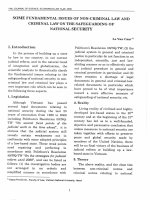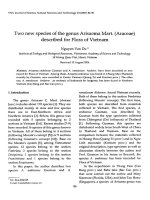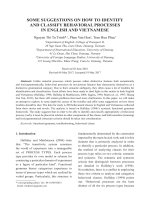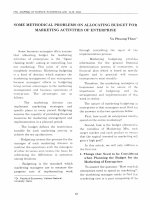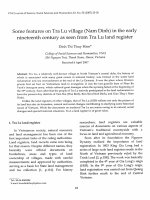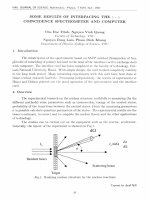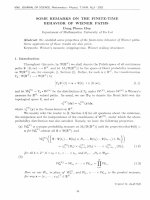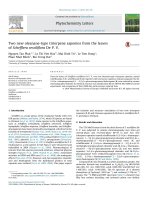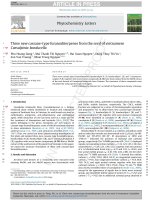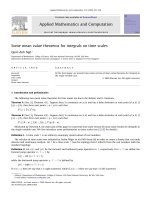DSpace at VNU: SOME NEW RESULTS ON THE FEJ´ ER AND HERMITE-HADAMARD INEQUALITIES
Bạn đang xem bản rút gọn của tài liệu. Xem và tải ngay bản đầy đủ của tài liệu tại đây (110.74 KB, 12 trang )
ROCKY MOUNTAIN
JOURNAL OF MATHEMATICS
Volume 43, Number 5, 2013
SOME NEW RESULTS ON
´ AND HERMITE-HADAMARD INEQUALITIES
THE FEJER
ˆ´C-ANH NGO
ˆ
VU NHAT HUY AND QUO
ABSTRACT. The Hermite-Hadamard inequality and its
generalization, the Fej´
er inequality, have many applications.
A simple application is to approximate the definite integral
b
f (x) dx if the function f is convex. In this short note, we
a
show how to relax the convexity property of the function f ,
and thus we obtain inequalities that involve a larger class of
functions. This new study also raises some open questions.
1. Introduction. The Hermite-Hadamard inequality [5, 6] says
that
(1)
f
a+b
2
1
b−a
b
a
f (t) dt
f (a) + f (b)
2
holds for any convex function f : I → R and a, b ∈ I.
As a generalization of (1), the Fej´er inequality [4] says that
(2)
b
b
a+b
f (a) + f (b) b
p(x) dx
f (x)p(x) dx
p(x) dx
f
2
2
a
a
a
holds for any convex function f : I → R, where a, b ∈ I and p : [a, b] →
R is non-negative integrable and symmetric about x = (a + b)/2.
Apparently, inequality (2) goes back to inequality (1) if we put
p ≡ 1/(b − a). Inequalities (1) and (2) provide a simple way to evaluate
b
the integral a f (x) dx. These inequalities have many extensions and
generalizations, see [1, 2, 7 9]. In this paper we present some new
refinements of inequalities (1) and (2).
Keywords and phrases. Integral inequality, Fej´
er, Hermite-Hadamard.
This work was partially supported by the Vietnam National Foundation for
Science and Technology Development (Project No 101. 01. 50. 09).
The second author is the corresponding author.
Received by the editors on July 28, 2010, and in revised form on February 2,
2011.
DOI:10.1216/RMJ-2013-43-5-1625
Copyright c 2013 Rocky Mountain Mathematics Consortium
1625
ˆ´C-ANH NGO
ˆ
VU NHAT HUY AND QUO
1626
Obviously, inequality (2) can be rewritten as
(3)
f
a+b
2
b
f (a) + f (b)
2
−
b
a
p(x) dx
a
f (x)p(x) dx −
f (a) + f (b)
2
b
a
p(x) dx
0
and
b
0
a
(4)
f (x)p(x) dx − f
a+b
2
f (a) + f (b)
a+b
−f
2
2
b
a
p(x) dx
b
a
p(x) dx
which says that
b
a
f (x)p(x) dx −
f (a) + f (b)
2
0
b
a
b
a
p(x) dx
f (x)p(x) dx − f
a+b
2
b
a
p(x) dx.
We observe that, under certain conditions, we can relax the convexity
property of function f . This is the aim of the present paper.
Precisely, both inequalities (1) and (2) require function f to be
convex; as a consequence, it is natural to assume that f is twice0. Our first result concerns the
differentiable. Consequently, f
case when f is bounded in [a, b]. Note that, we do not require f to
be non-negative. Precisely, we first prove the following result:
Theorem 1. Suppose p(x)
0 is symmetric about (a + b)/2 and
f : [a, b] → R is a twice-differentiable function such that f is bounded
´ AND HERMITE-HADAMARD INEQUALITIES
THE FEJER
1627
in [a, b]. Then
(a+b)/2
(5) m
2
a+b
−x
2
a
p(x) dx
b
a
f (x)p(x) dx − f
(a+b)/2
M
a+b
2
a+b
−x
2
a
2
b
p(x) dx
a
p(x) dx
and
(6)
−M
(a+b)/2
a
(x − a)(b − x)p(x) dx
b
a
f (x)p(x) dx −
−m
(a+b)/2
a
f (a) + f (b)
2
b
a
p(x) dx
(x − a)(b − x)p(x) dx
where
m = inf f (t),
M = sup f (t).
t∈[a,b]
Remark 1. If f
inequality (2).
t∈[a,b]
0, then we obtain an improvement of the Fej´er
Next we consider the case when f is of class Lp ([a, b]); we also obtain
the following estimates:
Theorem 2. Let 1 < p < ∞ and p(x)
0 be symmetric about
(a + b)/2 and f : [a, b] → R be a twice-differentiable function such that
f ∈ Lp ([a, b]). Then
b
(7)
a
f (x)p(x) dx − f
b
a+b
2
q
f
2(q + 1)
p
p(x) dx
a
(a+b)/2
a
(a + b − 2x)(1/q)+1 p(x) dx
ˆ´C-ANH NGO
ˆ
VU NHAT HUY AND QUO
1628
and
f (a) + f (b)
2
(8)
q
f
2(q + 1)
b
a
p(x) dx −
(a+b)/2
p
a
b
a
f (x)p(x) dx
(b−a)(1/q)+1 −(a+b−2x)(1/q)+1 p(x) dx,
where q is defined to be p/(p − 1).
Finally, it is clear to see that inequality f
0 implies that f is
non-decreasing. Therefore, in the next result, we assume that
(9)
f (a + b − x)
f (x),
for all x ∈ a,
a+b
.
2
Clearly, if f is non-decreasing, then inequality (9) holds. However, it
is obvious to see that the reverse statement is not true.
Theorem 3. Suppose that p(x) 0 is symmetric about (a + b)/2 and
f : [a, b] → R is a differentiable function satisfying f (a+b−x) f (x),
for all x ∈ [a, (a + b)/2]. Then
(10)
b
b
a+b
f (a) + f (b) b
p(x) dx
f (x)p(x) dx
p(x) dx
f
2
2
a
a
a
holds.
Remark 2. It is worth noticing that the assumption f is a differentiable function which has been used in the literature; for example, in
[3] the authors assumed f is convex on [a, b]. They then obtained some
refinements of the Hermite-Hadamard inequality (1).
By using Theorems 1 3, it turns out that the question of deriving
a sharp version becomes open. We hope that we will soon see some
responses on this problem.
´ AND HERMITE-HADAMARD INEQUALITIES
THE FEJER
1629
2. Proofs.
Proof of Theorem 1. We firstly prove (5). Since p(x)
about (a + b)/2, we have
b
a
b
f (x)p(x) dx =
a
b
=
a
0 is symmetric
f (a + b − x)p(a + b − x) dx
f (a + b − x)p(x) dx.
So
b
(11)
a
f (x)p(x) dx =
1
2
b
f (x) + f (a + b − x) p(x) dx,
a
which gives
b
a
f (x)p(x) dx − f
=
1
2
b
a
a+b
2
b
a
p(x) dx
f (x) + f (a + b − x) − 2f
Since
f (x) + f (a + b − x) − 2f
a+b
2
a+b
2
p(x) dx .
p(x)
is symmetric about (a + b)/2, one has
b
a
f (x) + f (a + b − x) − 2f
(a+b)/2
=2
a
a+b
2
p(x) dx
f (x) + f (a + b − x) − 2f
a+b
2
p(x) dx,
a+b
2
p(x) dx.
which implies
b
(12)
a
f (x)p(x) dx − f
(a+b)/2
=
a
a+b
2
b
a
p(x) dx
f (x) + f (a + b − x) − 2f
ˆ´C-ANH NGO
ˆ
VU NHAT HUY AND QUO
1630
Since
f (a + b − x) − f
a+b
2
and
f
a+b
2
− f (x) =
a+b−x
=
(a+b)/2
f (t) dt
(a+b)/2
f (t) dt,
x
then
f (x) + f (a + b − x) − 2f
a+b
2
a+b−x
=
(a+b)/2
f (t) dt −
(a+b)/2
(a+b)/2
f (t) dt
x
f (a + b − t) dt −
=
x
(a+b)/2
x
f (t) dt.
Therefore,
(13) f (x) + f (a + b − x) − 2f
a+b
2
(a+b)/2
=
x
f (a + b − t) − f (t) dt.
Since
f (a + b − t) − f (t) =
(14)
a+b−t
f (y) dy
t
then for t ∈ [a, (a + b)/2], one has
m(a + b − 2t)
f (a + b − t) − f (t)
M (a + b − 2t).
Thus,
(a+b)/2
x
m(a + b − 2t) dt
f (x) + f (a + b − x) − 2f
(a+b)/2
x
M (a + b − 2t) dt.
a+b
2
´ AND HERMITE-HADAMARD INEQUALITIES
THE FEJER
1631
A simple calculation shows us that
m
a+b
−x
2
2
a+b
2
f (x) + f (a + b − x) − 2f
a+b
−x
2
M
2
.
Then
(a+b)/2
m
a+b
−x
2
a
2
p(x) dx
b
a
f (x)p(x) dx − f
(a+b)/2
M
a+b
2
2
a+b
−x
2
a
b
a
p(x) dx
p(x) dx.
This completes the proof of (5). We now prove (6). By using (11), one
has
b
a
f (x)p(x) dx −
=
1
2
f (a) + f (b)
2
b
a
b
a
p(x) dx
f (x) + f (a + b − x) − f (a) + f (b)
p(x) dx .
Since the following function
f (x) + f (a + b − x) − f (a) + f (b)
p(x)
is symmetric about (a + b)/2, one gets
b
(15)
a
f (x)p(x) dx −
(a+b)/2
=
a
f (a) + f (b)
2
b
a
p(x) dx
f (x) + f (a + b − x) − f (a) + f (b)
Since
f (b) − f (a + b − x) =
b
a+b−x
f (t) dt
p(x) dx.
ˆ´C-ANH NGO
ˆ
VU NHAT HUY AND QUO
1632
and
x
f (x) − f (a) =
f (t) dt,
a
then we have
f (x) + f (a + b − x) − f (a) + f (b)
x
=
a
x
=
a
f (t) dt −
f (t) dt −
b
a+b−x
x
a
f (t) dt
f (a + b − t) dt.
Therefore,
(16) f (x) + f (a + b − x) − f (a) + f (b)
x
=−
a
f (a + b − t) − f (t) dt.
We also have
f (a + b − t) − f (t) =
(17)
a+b−t
t
f (y) dy
which implies, for t ∈ [a, (a + b)/2], that
m(a + b − 2t)
f (a + b − t) − f (t)
M (a + b − 2t).
Hence,
−
x
a
M (a + b − 2t) dt
f (x) + f (a + b − x) − f (a) + f (b)
−
x
a
m(a + b − 2t) dt.
Thus,
−M (x − a)(b − x)
f (x) + f (a + b − x) − f (a) + f (b)
−m(x − a)(b − x).
´ AND HERMITE-HADAMARD INEQUALITIES
THE FEJER
1633
It follows that
−M
(a+b)/2
a
(x − a)(b − x)p(x) dx
b
a
f (x)p(x) dx −
−m
(a+b)/2
a
f (a) + f (b)
2
b
a
p(x) dx
(x − a)(b − x)p(x) dx.
The proof is complete.
Proof of Theorem 2. We firstly prove (7). From (12) (13), one has
b
a
a+b
2
f (x)p(x) dx − f
=
1
2
b
a
(a+b)/2
=
a
b
a
p(x) dx
f (x) + f (a + b − x) − 2f
a+b
2
f (x) + f (a + b − x) − 2f
a+b
2
p(x) dx
p(x) dx
and
a+b
2
f (x) + f (a + b − x) − 2f
(a+b)/2
=
x
f (a + b − t) − f (t) dt.
Note that, by (14),
f (a + b − t) − f (t) =
where a
t
a+b−t
f (y) dy
t
(a + b)/2, which implies
|f (a + b − t) − f (t)|
1/q
a+b−t
t
t
1/q
a+b−t
t
a+b−t
dy
dy
= (a + b − 2t)1/q f
f
p.
p
| f (y)|p dy
1/p
ˆ´C-ANH NGO
ˆ
VU NHAT HUY AND QUO
1634
Thus,
b
a
f (x)p(x)dx − f
b
a+b
2
p(x) dx
a
(a+b)/2
q
f
2(q + 1)
p
a
(a + b − 2x)(1/q)+1 p(x) dx.
The proof of (7) is complete. We now prove (8). From (15) (16), one
has
b
f (a) + f (b)
2
a
p(x) dx −
b
1
2
b
f (x)p(x) dx
a
f (x) + f (a + b − x) − f (a) + f (b) p(x) dx
a
(a+b)/2
a
f (x) + f (a + b − x) − f (a) + f (b) p(x) dx
and
x
f (x) + f (a + b − x) − f (a) + f (b)
f (a + b − t) − f (t) dt.
a
Note that, by (17),
f (a + b − t) − f (t) =
where a
t
a+b−t
f (y) dy
t
(a + b)/2, which implies
1/q
a+b−t
|f (a + b − t) − f (t)|
a+b−t
dy
t
t
1/p
1/q
a+b−t
dy
t
|f (y)|p dy
f
= (a + b − 2t)1/q f
p
p.
Therefore,
f (a) + f (b)
2
q
f
2(q + 1)
b
a
p(x) dx −
(a+b)/2
p
a
b
a
f (x)p(x) dx
(1/q)+1
(b − a)
(1/q)+1
−(a + b − 2x)
p(x) dx.
´ AND HERMITE-HADAMARD INEQUALITIES
THE FEJER
1635
Proof of Theorem 3. The proof of Theorem 3 comes from the proofs
of Theorems 1 and 2. From (12) and (13), one has
b
a
f (x)p(x) dx − f
(a+b)/2
b
a+b
2
a
(a+b)/2
=
a
x
p(x) dx
f (a + b − t) − f (t) dt p(x) dx.
Similarly, from (15) and (16), one gets
f (a) + f (b)
2
b
a
p(x) dx −
b
a
f (x)p(x) dx
(a+b)/2
x
=
a
a
f (a + b − t) − f (t) dt p(x) dx.
Thus, the proof follows from the assumption.
Acknowledgments. The authors wish to express their gratitude
to the anonymous referee for a number of valuable comments and
suggestions which helped to improve the presentation of the paper.
REFERENCES
1. J.L. Brenner and H. Alzer, Integral inequalities for concave functions with
applications to special functions, Proc. Roy. Soc. Edinburgh 18 (1991), 173 192.
2. S.S. Dragomir, On Hadamards inequalities for convex functions, Math. Balkan.
6 (1992), 215 222.
3. S.S. Dragomir and R.P. Agarwal, Two inequalities for differentiable mappings
and applications to special means of real numbers and to trapezoidal formula, Appl.
Math. Lett. 11 (1998), 91 95.
4. L. Fej´
er, Uberdie fourierreihen, II, Math. Natur. Ungar. Akad. Wiss. 24 (1906),
369 390.
´
5. J. Hadamard, Etude
sur les proprietes des fonctions entieres et en particulier
d’une fonction consideree par Riemann, J. Math. Pures Appl. 58 (1893), 171 215.
6. J.E. Pecaric, F. Proschan and Y.L. Tong, Convex functions, partial orderings,
and statistical applications, Academic Press, New York, 1992.
7. K.L. Tseng and C.S. Wang, Some refinements of the Fej´
ers inequality for
convex functions, Tamsui Oxford J. Math. Sci. 21 (2005), 94 104.
8. G.S. Yang, D.Y. Hwang and K.L. Tseng, Some inequalities for differentiable
convex and concave mappings, Comput. Math. Appl. 47 (2004), 207 216.
1636
ˆ´C-ANH NGO
ˆ
VU NHAT HUY AND QUO
9. G.S. Yang and K.L. Tseng, On certain integral inequalities related to HermiteHadamard inequalities, J. Math. Anal. Appl. 239 (1999), 180 187.
Department of Mathematics, College of Science, Viˆ
et Nam National
` No
ˆ i, Viˆ
University, Ha
et Nam
Email address: nhat
Department of Mathematics, National University of Singapore, Block
S17 (SOC1), 10 Lower Kent Ridge Road, Singapore 119076 and Laboratoire de Math´
ematiques et de Physique Th´
eorique UFR Sciences et
Technologie, Universit´
e Franc
¸ ois Rabelais Parc de Grandmont, 37200
Tours, France
Email address: bookworm
